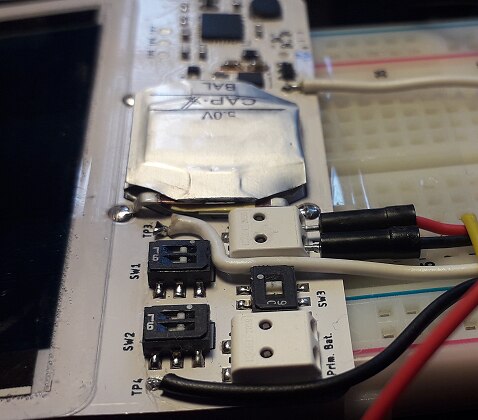I received a preview of a light harvesting kit from Epishine and element14. Check my intro here.
In this post, an analysis of the electronic properties. Charging, discharging, powering a load.
image source: my board, with probe wires soldered to the test points
The Test Conditions
I've set the output to 1.8 V. That's one of the voltages specified in Epishine's draft spec.
Light conditions: my lab during daytime, on a bright summer noon. No direct sunlight or artificial light.
When a load was attached, it was a 590 Ohm resistor. Drawing 3 mA.
No battery.
VCAP recorded with a Kithley DMM6500.
A DMM checking VOUT. This is not recorded, I just used it to see when voltage switched off or on.
A raw CSV file with all measures is attached. I've also added a spreadsheet in ODS format with the graph used in this post.
I deliberately used a non-lab setting. My setup is a reasonable ambient light situation.
For a lab-based analysis, see the graph from the designers below:
image source: scan of Epishine's draft spec
As you'll see later, my test results are in line with the lab-based results. Maybe, in a later test, I'll redo their test from an empty cap until VCAP reaches 3.9 V.
If it is of interest to anyone, because these are long and non-exciting test exercises.
Test Results
The test in this blog took 2 hours and 15 minutes. It's automated, I did not have to check and write down measurements.
I only did one intervention: adding a 590 Ohm load after the super cap reached a steady charge.
The total amount of samples: 37770 measurements of VCAP, with timestamp.
these scenarios are captured:
- charge without load
- 3 discharges with load
- 2 charges with load, under slightly different lighting conditions.
image source: my samples, in blue. All the other artifacts are manually annotated. They aren't measurements but are representative for what happened.
The first ramp up in the dark blue line is when I have no load attached.
The solar cell charges the capactor up to 4.5 V. That's the maximum in this design.
You see a knee at 3.9 V, where the ramp flattens more than the typical exponential capacitor charge curve. That's when the output gets enabled.
Even though there's no load, the LDO and boost converters at the output steal some power.
Conform to the specifications, the 1.8 V output switches on when the supercap reaches the 3.9 V.
Because the output is not loaded, the solar cell can continue to charge the capacitor.
At the point where the capacitor reaches the 4.5 V maximum, I inserted a 590 Ohm resistor. This draws 3 mA from the output.
You can immediately see that charge is taken from the supercap.
The design will keep on providing 1.8 V at 3 mA until VCAP reaches that 1.8 V.
It was able to do that - with the supercap first allowed to get its maximum charge - for 858 seconds, 14 minutes
Here is the zoom in of the first discharge ramp, where VCAP starts from 4.5 V, Vout = 1.8 V, Iout = 3 mA
data range in sample spreadsheet: $supercap1.$A$19001:$A$23245
Start time: 3839.588863681 s
End time: 4697.276276045 s
duration: 857.687412364 s
This is 1.287 mWh.
Then the next discharge phase is one where we the load is attached and the design immediately start to take power when VCAP reached it's minimum: 3.9 V
data range in sample spreadsheet: $supercap1.$A$27185:$A$29750
Start time: 5493.527778257 s
End time: 6011.899451787 s
duration: 518.371673529999
That's 0.777 mWh.
| Related blog |
|---|
| Pt 1: intro |
| Pt 2: Circuit Analysis |
| Pt 3: Charge and Discharge |
| Pt 4: Battery Backup |
| Pt 5: test points |







